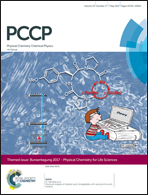Effect of ion–ligand binding on ion pairing dynamics studied by two-dimensional infrared spectroscopy†
Abstract
Cation-specific ion pairing dynamics between M+ (M = Ag or Cu) and SCN− in N,N-dimethylthioformamide (DMTF) are studied by probing the nitrile (CN) stretching vibration. The SCN− ion, which is an ambidentate ligand, readily associates with cations to form two different types of contact ion pairs (CIPs) (i.e., M-SCN or M-NCS) and its CN stretching frequency is significantly blue-shifted so that free SCN− and CIPs can be well-distinguished in the FTIR spectra. Interestingly, Ag+ ions prefer the formation of Ag-SCN in DMTF (Ag+ + SCN− ![[leftrightharpoons]](https://www.rsc.org/images/entities/char_21cb.gif) Ag-SCN) but Cu+ ions form Cu-NCS (Cu+ + SCN−
Ag-SCN) but Cu+ ions form Cu-NCS (Cu+ + SCN− ![[leftrightharpoons]](https://www.rsc.org/images/entities/char_21cb.gif) Cu-NCS). We have studied the effect of ion–ligand binding on the ion pairing equilibria and dynamics in great detail by using FTIR, IR pump–probe (IR PP), and two-dimensional infrared (2DIR) spectroscopy combined with quantum chemical calculations. First, our quantum chemical calculations corroborate that Ag-SCN and Cu-NCS of the two possible CIP configurations (M-SCN or M-NCS) are energetically stable and favored in DMTF. Second, the thermodynamic properties (ΔH and ΔS) of ion pairing equilibria are determined by temperature-dependent FTIR experiments. Finally, IR PP and 2DIR experiments are used to measure the association and dissociation rate constants. The ion pairing dynamics between Cu+ and SCN− are found to occur on much faster timescales than those between Ag+ and SCN−. Our current results provide important insights into understanding the effect of ion–ligand binding on the ion pairing equilibria and dynamics in polar solvents.
Cu-NCS). We have studied the effect of ion–ligand binding on the ion pairing equilibria and dynamics in great detail by using FTIR, IR pump–probe (IR PP), and two-dimensional infrared (2DIR) spectroscopy combined with quantum chemical calculations. First, our quantum chemical calculations corroborate that Ag-SCN and Cu-NCS of the two possible CIP configurations (M-SCN or M-NCS) are energetically stable and favored in DMTF. Second, the thermodynamic properties (ΔH and ΔS) of ion pairing equilibria are determined by temperature-dependent FTIR experiments. Finally, IR PP and 2DIR experiments are used to measure the association and dissociation rate constants. The ion pairing dynamics between Cu+ and SCN− are found to occur on much faster timescales than those between Ag+ and SCN−. Our current results provide important insights into understanding the effect of ion–ligand binding on the ion pairing equilibria and dynamics in polar solvents.



 Please wait while we load your content...
Please wait while we load your content...